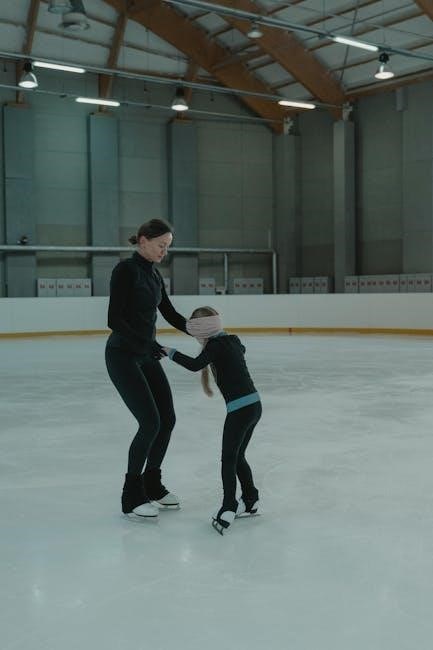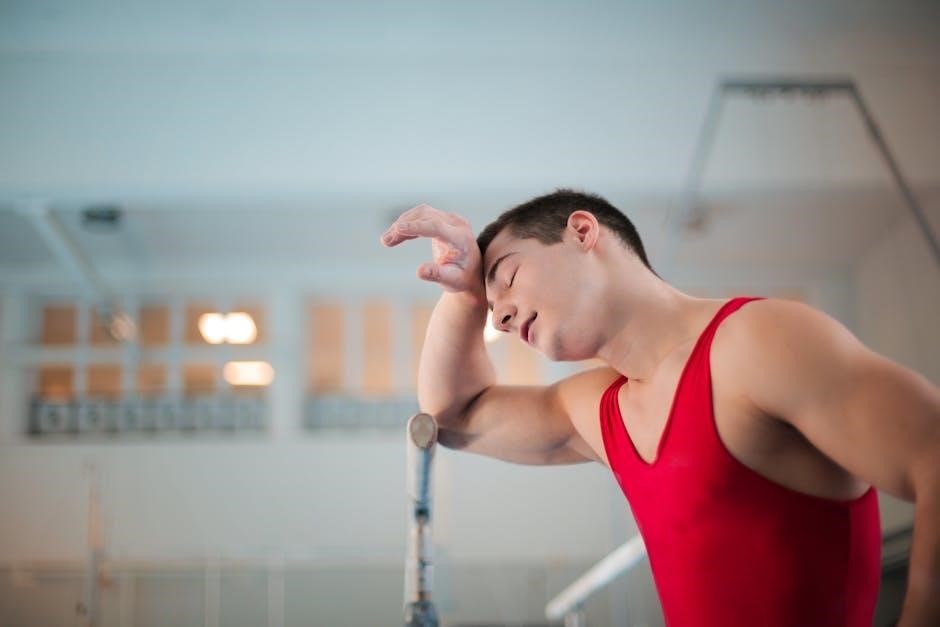Spondylolisthesis is a condition where a vertebra slips out of place in the spine‚ often causing lower back pain and instability. It is commonly graded by severity‚ with higher grades indicating greater displacement. This condition can lead to spinal nerve compression and discomfort‚ especially during physical activity. Exercises play a crucial role in managing symptoms by improving spinal stability and reducing pain.
1.1 What is Spondylolisthesis?
Spondylolisthesis is a spinal condition where a vertebra slips forward relative to the vertebra below it‚ often causing lower back pain and instability. It can result from degenerative changes‚ congenital abnormalities‚ or traumatic injuries. Symptoms may include pain‚ muscle spasms‚ and limited mobility. The condition is typically graded based on the degree of vertebral displacement‚ with higher grades indicating more severe slippage. Exercises play a key role in managing symptoms and improving stability.
1.2 Types of Spondylolisthesis
Spondylolisthesis is categorized based on the severity of vertebral slippage‚ typically graded on a scale from 1 to 5. Grade 1 indicates minimal slippage‚ while Grade 5 signifies complete displacement. The condition can also be classified as degenerative‚ congenital‚ or fracture-related. Understanding these types is crucial for developing appropriate exercise programs to manage symptoms and improve spinal stability.
Understanding the Role of Exercises in Managing Spondylolisthesis
Exercises play a vital role in managing spondylolisthesis by improving spinal stability‚ reducing pain‚ and enhancing flexibility. They are a cornerstone of non-surgical treatment.
2.1 Importance of Exercise Therapy
Exercise therapy is essential for managing spondylolisthesis‚ as it strengthens core muscles‚ improves spinal stability‚ and enhances flexibility; It reduces pain and prevents progression by addressing muscle imbalances. Regular exercise can delay or avoid surgery‚ promoting long-term spinal health and improving overall quality of life for individuals with this condition.
2.2 Goals of Exercise Programs
The primary goals of exercise programs for spondylolisthesis are to enhance spinal stability‚ improve strength‚ and increase flexibility. These exercises aim to reduce pain‚ prevent further vertebrae slippage‚ and restore functional movement. By targeting core muscles and improving posture‚ patients can achieve better mobility and long-term spinal health‚ reducing the need for surgical intervention.

Key Principles for Safe and Effective Exercises
Safe exercises for spondylolisthesis focus on avoiding spinal loading‚ excessive lumbar extension‚ and high-impact activities. Emphasizing controlled movements‚ gradual progression‚ and pain monitoring ensures effectiveness and prevents aggravation.
3;1 Avoiding Lumbar Extension and Spinal Loading
Exercises for spondylolisthesis should avoid movements that involve lumbar extension‚ such as arching the back‚ as this can worsen the condition. Spinal loading‚ which increases pressure on the vertebrae‚ should also be minimized. Activities like heavy lifting or high-impact sports are typically avoided in the early stages of treatment to prevent further injury and promote healing.
3.2 Progression of Exercises
Exercise progression for spondylolisthesis begins with gentle movements and gradually increases intensity. Initially‚ focus on pain-free activities like pelvic tilts and breathing exercises. As strength and stability improve‚ introduce resistance bands or light weights. Dynamic movements‚ such as bridging or bird-dog exercises‚ are added later. Progression should be slow‚ ensuring no increase in pain‚ and tailored to individual tolerance and improvement.
3.3 Pain Management During Exercises
Pain management during exercises for spondylolisthesis involves monitoring discomfort levels‚ ensuring it does not exceed 3/10. Techniques include modifying exercises to avoid aggravation‚ incorporating relaxation methods‚ and using manual therapy. Activities should be paused if pain increases‚ and consultation with a physical therapist is recommended to adjust routines safely and effectively‚ promoting healing without exacerbating the condition.

Gentle Exercises for the Initial Phase
Initial exercises focus on gentle movements to avoid aggravation. These include pelvic tilts‚ light stretching‚ and breathing techniques to stabilize the spine and reduce discomfort gradually.
4.1 Pelvic Tilt Exercises
Pelvic tilt exercises are essential for initial phases. Lie on your back with knees bent and feet flat. Engage abdominal muscles to gently tilt the pelvis‚ flattening the lower back against the floor. Perform 10-15 repetitions‚ focusing on controlled movements. This exercise strengthens core muscles and improves spinal alignment without putting excessive strain on the vertebrae.
4.2 Gentle Stretching Routines
Gentle stretching focuses on improving flexibility without strain. Techniques like child’s pose‚ cat-cow stretches‚ and seated forward bends are effective. These exercises target tight muscles in the hamstrings‚ hip flexors‚ and lower back‚ promoting relaxation and reducing tension. Performed slowly and within a pain-free range‚ they enhance mobility and prepare the spine for more advanced movements.
4.3 Breathing and Relaxation Techniques
Deep breathing and relaxation methods help reduce muscle tension and alleviate pain. Techniques like diaphragmatic breathing and guided imagery promote calming effects. These practices‚ often combined with gentle stretches‚ improve oxygen flow and reduce stress‚ enhancing the effectiveness of other exercises. Regular practice fosters a relaxed state‚ making physical therapy more manageable and supportive of overall spinal health.

Strengthening Exercises for Spondylolisthesis
Strengthening exercises target core muscles‚ hip flexors‚ and lower back to enhance spinal stability. These exercises reduce pain and improve posture‚ crucial for managing spondylolisthesis effectively.
5.1 Core Strengthening Exercises
Core strengthening exercises‚ such as planks and pelvic tilts‚ are essential for stabilizing the spine in spondylolisthesis. These exercises target abdominal muscles and improve posture‚ reducing strain on the lower back. Regular practice enhances spinal alignment and prevents further slippage‚ promoting long-term stability and pain relief. Consistency is key to achieving optimal results and maintaining spinal health.
5.2 Hip and Lower Back Strengthening
Hip and lower back strengthening exercises‚ such as bridges and bird-dog exercises‚ target the muscles around the spine and pelvis. These exercises improve spinal stability and reduce discomfort. By enhancing the strength of the glutes and lower back muscles‚ they help alleviate pain and support the spine‚ promoting better posture and movement. Regular practice is vital for long-term spinal health and functionality.
5.3 Abdominal Workouts
Abdominal workouts‚ such as gentle planks and pelvic tilts‚ are essential for strengthening the core muscles that support the spine; These exercises help improve spinal stability and reduce pain by engaging the transverse abdominis muscle. Proper form is crucial to avoid strain on the lower back. Regular practice enhances overall core strength‚ which is vital for managing spondylolisthesis effectively and promoting long-term spinal health.

Stretching Exercises for Flexibility
Stretching exercises‚ such as hamstring and hip flexor stretches‚ help improve flexibility and reduce muscle tightness‚ which can alleviate discomfort and promote better spinal alignment in spondylolisthesis.
6;1 Hamstring and Hip Flexor Stretching
Hamstring and hip flexor stretching are essential to improve flexibility and reduce tightness that can exacerbate spondylolisthesis symptoms. These stretches‚ such as the supine hamstring stretch‚ help relieve tension in the lower back and promote proper spinal alignment. Regular practice can enhance mobility and decrease discomfort‚ making daily activities more manageable and reducing the risk of further injury.
6;2 Piriformis and Thoracic Mobilization
Piriformis and thoracic mobilization exercises target tight muscles and improve spinal mobility. Stretching the piriformis reduces pressure on the sciatic nerve‚ alleviating pain. Thoracic mobilization enhances upper back flexibility‚ promoting better posture and reducing strain on the lower spine. These exercises‚ when done consistently‚ can significantly enhance overall spinal stability and comfort for individuals with spondylolisthesis.
6.3 Supine Hamstring Stretch
The supine hamstring stretch is performed by lying on your back with one leg straight and the other bent. Gently pull the straight leg toward your chest until a stretch is felt in the back of the thigh. Hold for 30 seconds and repeat daily. This exercise helps reduce hamstring tightness‚ improving flexibility and alleviating lower back pain associated with spondylolisthesis.

Lumbar Stabilization Exercises
Lumbar stabilization exercises strengthen core muscles‚ enhancing spinal stability and reducing pain. Techniques like neutral spine positioning and pelvic exercises improve posture and protect the spine during activity.
7.1 Neutral Spine Positioning
Neutral spine positioning is a fundamental technique in lumbar stabilization‚ involving maintaining the spine’s natural curvature without flexion or extension. This position is achieved by engaging core muscles and pelvic floor‚ ensuring minimal stress on the spine. It serves as the foundation for various exercises‚ promoting proper posture and reducing the risk of further injury or strain.
7.2 Pelvic Clock Exercises
Pelvic clock exercises involve moving the pelvis in a controlled manner‚ simulating the movement of a clock. Starting in a supine position‚ the pelvis is gently rotated to positions such as 12 o’clock‚ 3 o’clock‚ and 6 o’clock. These exercises improve pelvic mobility‚ strengthen core muscles‚ and enhance spinal stability‚ reducing discomfort and promoting proper alignment for individuals with spondylolisthesis.
7.3 Bird-Dog Exercises
Bird-dog exercises strengthen the core and improve spinal stability by extending the arms and legs while maintaining a neutral spine; Starting on hands and knees‚ extend the right arm and left leg simultaneously‚ holding briefly. This exercise enhances balance‚ promotes proper posture‚ and reduces the risk of further vertebral slippage in spondylolisthesis patients‚ improving overall spinal function and reducing discomfort.

Advanced Exercises for Progression
Advanced exercises like single-leg deadlifts‚ front squats‚ and lunges build strength and balance‚ progressing from foundational movements to more dynamic‚ functional activities for spinal stability.
8.1 Single-Leg Deadlifts
Single-leg deadlifts enhance balance‚ stability‚ and strength in the lower back and hips. Perform by standing on one leg‚ hinging at the hips‚ and lowering the torso‚ keeping the back straight. This exercise mimics functional movements‚ improving core engagement and reducing spinal strain. Start with bodyweight and gradually add resistance as strength increases.
8.2 Front Squats and Lunges
Front squats and lunges are advanced exercises that strengthen the quadriceps‚ glutes‚ and core muscles‚ enhancing spinal stability. Perform front squats with a barbell or weights‚ keeping the chest upright and knees aligned with toes. Lunges target unilateral strength‚ improving balance and reducing spinal strain. Start with bodyweight and progress to weighted versions‚ ensuring controlled movements to avoid injury and maximize benefits for spinal health.
8.3 Sports-Specific Exercises
Sports-specific exercises are tailored to the demands of an athlete’s sport‚ focusing on functional movements and injury prevention. For example‚ cricket players may perform rotational throws and plyometrics‚ while football players engage in agility drills. These exercises mimic game situations‚ enhancing strength‚ flexibility‚ and coordination. They are introduced after foundational stability and strength are achieved‚ ensuring safe progression and optimal performance in the athlete’s specific sport.

Manual Therapy and Physical Therapy
Manual therapy and physical therapy are essential for improving mobility‚ strength‚ and reducing pain in spondylolisthesis patients‚ supporting overall exercise therapy effectiveness.
9.1 Role of Physical Therapists
Physical therapists play a crucial role in managing spondylolisthesis by designing personalized exercise programs‚ improving mobility‚ and strengthening core muscles. They assess the patient’s condition‚ provide manual therapy techniques‚ and educate on proper posture and movement to reduce pain and prevent further injury‚ ensuring a safe and effective rehabilitation process tailored to individual needs.
9.2 Manual Resistance Activities
Manual resistance exercises‚ such as hip abduction and knee extensions‚ are often incorporated to strengthen muscles around the spine without putting excessive strain on the lower back. These controlled movements help improve stability and function‚ reducing pain and enhancing overall mobility for individuals with spondylolisthesis.
9.3 Soft Tissue Mobilization Techniques
Soft tissue mobilization focuses on releasing tension in muscles and connective tissues‚ particularly in the hamstrings‚ IT band‚ and hip flexors. Techniques like myofascial release improve circulation and reduce stiffness‚ enhancing flexibility and comfort for individuals with spondylolisthesis. These methods complement exercise routines by addressing muscle imbalances and promoting recovery.
Creating a Home Exercise Program
A well-structured home program includes daily exercises tailored to individual needs‚ focusing on core strength‚ flexibility‚ and proper spinal mechanics. Start slowly‚ monitor progress‚ and ensure exercises are pain-free (pain ≤ 3/10). Consistency is key to achieving long-term benefits and improving spinal stability.
10.1 Structuring Daily Exercises
Structuring daily exercises involves creating a routine that balances strengthening‚ stretching‚ and stabilization. Begin with gentle movements like pelvic tilts and breathing techniques‚ progressing to core exercises and gentle stretches. Incorporate activities that avoid lumbar extension‚ ensuring exercises are low-impact and pain-free. Each session should be tailored to individual tolerance‚ with gradual intensity increases to promote healing and stability without overexertion.
10.2 Monitoring Progress and Adjustments
Monitoring progress involves tracking pain levels‚ exercise performance‚ and physical improvements. Regularly assess strength‚ flexibility‚ and spinal stability. Adjustments may include modifying exercise intensity‚ introducing new movements‚ or incorporating manual therapy. Consult with healthcare professionals to tailor the program‚ ensuring it remains effective and safe. Adjustments are crucial to avoid plateaus and address any changes in symptoms or capabilities.
10.3 Importance of Consistency
Consistency is key to achieving long-term benefits in managing spondylolisthesis. Regular performance of exercises ensures gradual strengthening of core and spinal muscles‚ improving stability and reducing pain. Irregular practice may lead to relapse or slowed progress. Commitment to daily routines fosters sustainable improvements‚ preventing further spinal misalignment and enhancing overall spinal health. Consistency is essential for maintaining therapeutic gains and avoiding recurrence of symptoms.
A well-structured exercise program significantly improves spinal stability and reduces pain in spondylolisthesis. Consistent practice enhances long-term outcomes‚ promoting overall spinal health and preventing symptom recurrence effectively.
11.1 Benefits of a Well-Structured Exercise Program
A well-structured exercise program for spondylolisthesis offers numerous benefits‚ including reduced pain‚ improved spinal stability‚ and enhanced posture. It strengthens core and back muscles‚ preventing further vertebral displacement. Regular practice also promotes flexibility‚ reduces stiffness‚ and improves overall physical function. Consistency in exercises can significantly delay or prevent the progression of the condition‚ ensuring long-term spinal health and quality of life.
11.2 Adherence to Exercise Routines
Consistent adherence to exercise routines is vital for managing spondylolisthesis effectively. Regular practice helps maintain spinal stability‚ prevents relapses‚ and enhances overall physical function. Patients should follow structured programs‚ monitor progress‚ and adjust exercises as needed. A physical therapist can provide guidance and motivation‚ ensuring safe and effective adherence. Over time‚ consistency fosters long-term benefits and improves quality of life for individuals with this condition.

